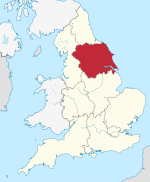
The Nidd Viaduct, also known as the Bilton Viaduct, is a former railway bridge in Bilton (just north of Harrogate), a village in North Yorkshire, northern England. It crosses the River Nidd and its gorge. It opened in 1847 and closed to trains in the 1960s. It is now a listed building and carries a cycling trail.
